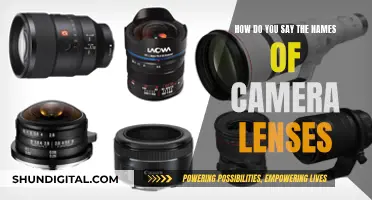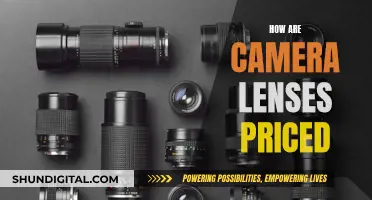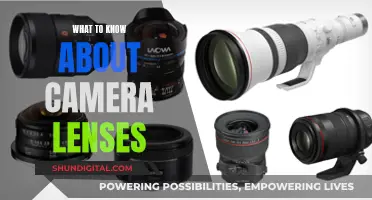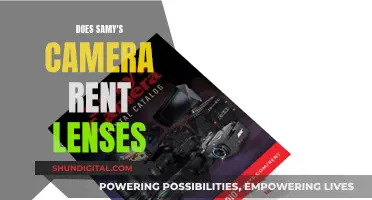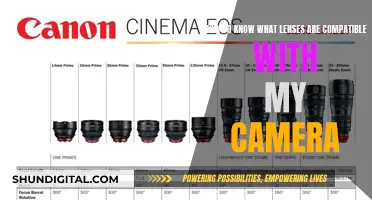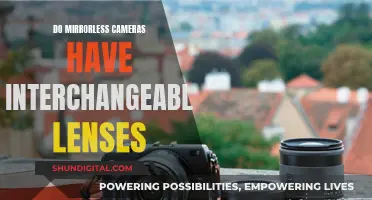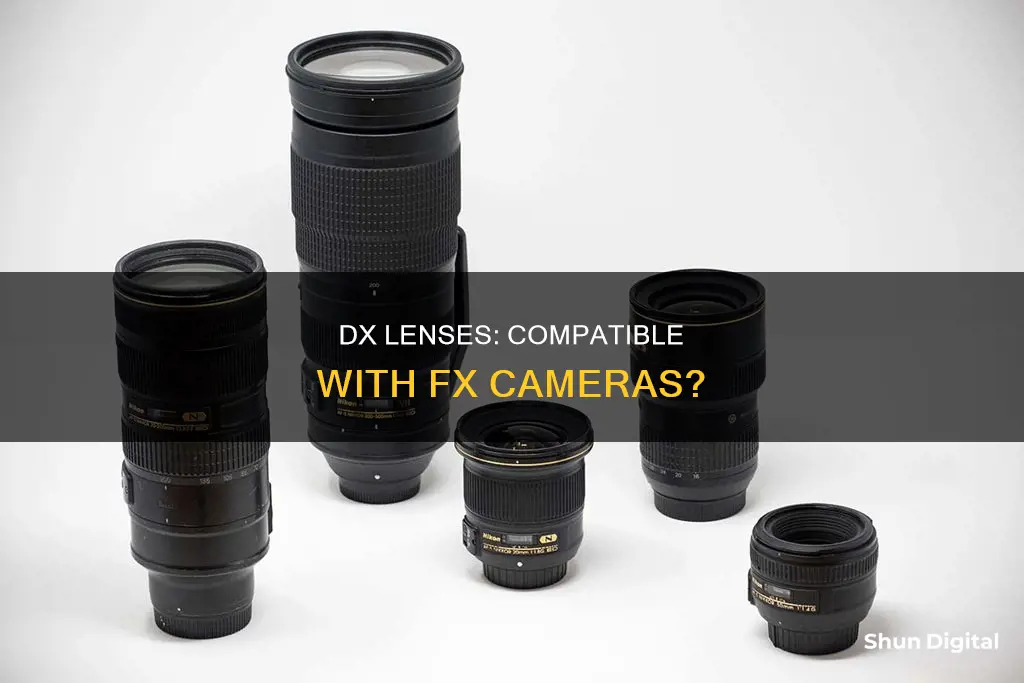
DX and FX refer to the size of a camera's image sensor. The DX-format is the smaller sensor at 24x16mm, while the FX-format sensor measures 36x24mm, which is approximately the same size as 35mm film. Different lenses are designed to accommodate these different camera sensor sizes.
If you're using a DX lens on an FX camera, the camera will automatically compensate by engaging its built-in DX crop mode, recording an image only from the centre section of the sensor. This results in a reduced image size and vignetting (darkening of the corners). However, some DX lenses can be used on FX cameras with only minor issues, and adapters are available to enable the use of DX lenses on mirrorless FX camera bodies.
| Characteristics | Values |
|---|---|
| Can DX lenses be used on an FX camera body? | Yes |
| What happens when a DX lens is used on an FX camera? | Vignetting, reduced image size, lower resolution, reduced image quality |
| Can FX lenses be used on a DX camera body? | Yes |
| What happens when an FX lens is used on a DX camera? | No vignetting, introduces a 1.5x crop factor |
What You'll Learn

Vignetting
When using a DX lens on an FX camera, the camera will automatically crop the image to fit the smaller sensor size of the DX lens. This cropping effectively turns your full-frame FX camera into an APS-C camera, resulting in a more zoomed-in image. While cropping can help mitigate vignetting, it also reduces the effective resolution of your images.
Some DX lenses may cover the full FX frame circle, resulting in less severe vignetting. For example, the Nikon 35mm f/1.8G DX and Tokina 11-16mm f/2.8 AT-X Pro DX lenses have been reported to exhibit bearable vignetting at larger apertures (larger than f/8). Additionally, the amount of vignetting can depend on the focal distance, with closer focal distances resulting in less pronounced vignetting.
It is important to note that not all FX cameras may have the option to disable auto-cropping. In such cases, using DX lenses will always result in cropped images, limiting the effective field of view and resolution.
In summary, while it is possible to use DX lenses on FX cameras, vignetting and cropping issues can significantly impact the final image quality. These limitations may be acceptable for certain types of photography, such as street photography, where the small size and portability of DX lenses can be advantageous. However, for wide-angle shots or situations where full-frame capabilities are essential, investing in dedicated FX lenses may be necessary.
Camera Kit Lenses: Worth the Money or Worthless?
You may want to see also

Image size
When using a DX lens on an FX camera, the camera automatically compensates for the smaller lens by engaging its built-in DX crop mode. This mode records an image only from the centre section of the sensor, effectively cropping the image to match the size of the DX sensor. As a result, the image file size is reduced to match the dimensions of a DX sensor image. For example, an FX image file on a Nikon Z5 typically has dimensions of 6016 x 4016 pixels, but when a DX lens is used with an adapter, the file size drops to 3936 x 2624 pixels.
The use of DX lenses on FX cameras can result in vignetting, or darkening of the corners, due to the smaller image circle projected by the lens. The amount of vignetting varies depending on the lens and can be more noticeable at certain focal lengths and apertures. However, some DX lenses may cover the full FX frame circle, resulting in usable images with minimal vignetting. Additionally, vignetting can be corrected to some extent in post-processing software.
It is important to note that while DX lenses can be used on FX cameras, the image quality may not be optimal. The centre performance of the lens may still be impressive, but the corners of the image may exhibit softness and aberrations. This is because the edges of the image are being cropped and scaled up to match the larger FX image size, resulting in a loss of sharpness.
In summary, while it is possible to use DX lenses on FX cameras, the image size will be reduced to match the dimensions of a DX sensor image due to the camera's built-in DX crop mode. Vignetting and image softness may also occur due to the smaller image circle projected by DX lenses. For optimal image quality and resolution, it is generally recommended to use FX lenses designed specifically for the larger FX sensor.
Anti-Camera Lenses: Worth the Investment?
You may want to see also

Image quality
When it comes to image quality, using DX lenses on an FX camera can result in vignetting, or darkening of the corners of the image. The amount of vignetting will vary depending on the lens and its aperture and focal length. Some DX lenses may also produce softer edges and more aberrations in the final image.
However, it is possible to use a DX lens on an FX camera and still get good image quality. For example, the Nikon 35mm f/1.8G DX lens performs well on an FX camera, with only minor vignetting that can be corrected in post-processing. The centre performance of this lens remains impressive, as it has been designed for this. Another DX lens that performs well on an FX camera is the Tokina 11-16mm f/2.8 AT-X Pro DX lens. When used on an FX camera, this lens produces some vignetting at 11mm, but the vignetting starts to disappear at 15mm, and by 16mm, it is almost nonexistent.
In general, FX cameras offer higher image quality than DX cameras, with better colour accuracy and low-light performance. FX sensors are larger and can gather more light, resulting in better low-light performance. They also have more dynamic range, which is beneficial for landscape photography. Additionally, FX sensors can have more pixels, offering more flexibility in cropping and printing.
However, it is important to note that the lens and camera body are not the only factors that determine image quality. Other factors such as lighting, subject, emotion, composition, and post-processing technique also play a significant role in creating stunning images.
Camera Contact Lenses: Fact or Fiction?
You may want to see also

Camera compatibility
First, it's important to understand the difference between DX and FX formats. The camera's format refers to the size of its image sensor. DX-format sensors are smaller, measuring 24x16mm, while FX-format sensors are larger, at 36x24mm, similar to 35mm film. DX lenses are designed for DX-format sensors and will have "DX" in their name, such as the AF-S DX Zoom-NIKKOR 12-24mm f/4G IF-ED. These lenses are smaller, lighter, and more affordable, making them a popular choice for photographers.
Now, let's address the question of compatibility. Can you use a DX lens on an FX camera? The answer is yes, with some limitations. When you mount a DX lens on an FX camera, the camera will automatically engage its built-in DX crop mode. This means that the camera will only record an image from the center section of the sensor, resulting in a smaller image file. For example, on a Nikon Z5, the FX file size is 6016 x 4016, but with a DX lens, it drops to 3936 x 2624. Additionally, you may experience vignetting, or darkening of the corners, with some DX lenses on an FX camera. The amount of vignetting will vary depending on the lens and camera combination.
It's also worth noting that while using a DX lens on an FX camera, you will have a smaller image circle projected onto the sensor. This can result in a tighter field of view, depending on the lens. For example, the Nikkor 10-24 DX zoom lens covers the full frame from about 15mm to 24mm, so the wide end remains similar, but the long end becomes 1.5x tighter on an FX body.
In summary, while it is possible to use DX lenses on FX cameras, there are some trade-offs. You may experience vignetting, a reduced image size, and a tighter field of view. If you plan to upgrade to an FX camera, it is generally recommended to invest in FX lenses to take full advantage of the larger sensor and avoid the limitations of DX lenses. However, if you already have DX lenses and want to test them on an FX camera, you can do so, and in some cases, the results may be quite usable.
Protect Your Camera Lens: Storage Tips for Photographers
You may want to see also

Lens cost
The cost of lenses varies depending on the type and specifications. For example, the Nikon 35mm f/1.8G DX lens is one of the most affordable options and is also one of the most popular lenses to date. On the other hand, high-quality FX lenses like the Nikon "trinity" lenses are known to be intimidatingly expensive, big, and heavy.
When considering the cost of lenses, it is also important to take into account the camera body that you will be using. For instance, if you are using a DX camera body, you may opt for DX lenses that are generally smaller, lighter, and more affordable. However, if you plan to upgrade to an FX camera body in the future, investing in FX lenses that are compatible with both DX and FX camera bodies may be more cost-effective in the long run.
Additionally, adapters can be used to attach DX lenses to FX camera bodies, but this may result in a reduced image file size and potential vignetting issues. The cost of adapters should also be factored in when considering the overall cost of your photography equipment.
It is worth noting that lens prices can vary depending on factors such as brand, specifications, and demand. It is always a good idea to research and compare prices from different manufacturers to find the best option that suits your budget and photography needs.
Double Lens Cameras: More Accurate or Just a Gimmick?
You may want to see also
Frequently asked questions
Yes, you can use a DX lens on an FX camera body. However, the camera will automatically engage its built-in DX crop mode, recording an image only from the centre section of the sensor to avoid vignetting. This will result in a lower-resolution image.
DX lenses are designed for cameras with smaller sensors, such as those found in DX-format cameras. They are smaller, lighter, and more affordable than FX lenses. FX lenses, on the other hand, are designed for full-frame cameras with larger sensors and offer higher sensitivity and lower noise.
When using a DX lens on an FX camera, the camera will either crop the image to fit the smaller sensor size or produce an image with vignetting (darkened corners). The amount of vignetting will vary depending on the lens and camera combination. In some cases, you may also notice softer edges and aberrations in the image.


